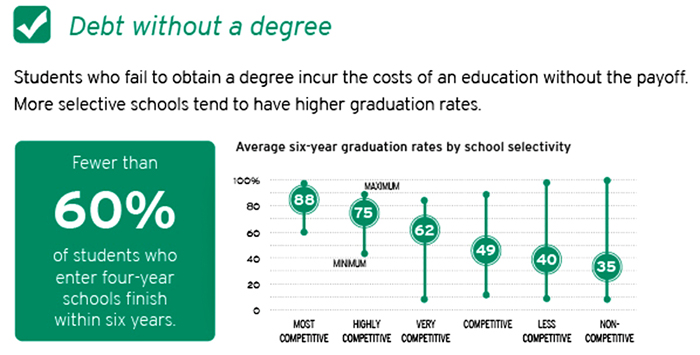
By Haddon Libby
Is a four-year college degree worth the time and money it takes to get one? According to a study by the Economic Policy Institute, the discrepancy between those with college degrees and those without has never been higher. An American with a four-year degree on average makes 98% more than a person without a degree.
Within these statistics, research found that less than 60% of people who enroll in college actually graduate. Amongst Hispanics, 50% graduate while only 40% of African Americans graduate. Amongst low-income students, 47% graduate while only 25% of part-time students complete their bachelor’s degree.
There is a strong correlation between the money that a graduate earns and their major. As a whole, those with engineering degrees were the most sought and best paid. Of the 2,339 students who graduated with a petroleum engineering degree between 2010 and 2012, the median pay was $110,000 annually.
In general, the most popular degrees are not the best paying. Business, a degree that 565,000 students majored in, led to a median pay of $39,000 of which 13% were considered low wage workers. Psychology majors accounted for 394,000 graduates with a median pay of $32,000 of which 16% were considered low-income workers. Counseling, educational and clinical psychologists were three of the lowest paying degrees at less than $25,000 annually. Worth noting, 75% of clinical psychology majors went on to graduate school with a median wage of $70,000 after graduation.
Not surprisingly, those who went on to study pre-med after graduation from college earned $135,000 annually after completing their studies, an $84,000 jump in their annual earnings. This was not the case for those in the educational field – school counselors, educators and administrators see only modest boosts in their income for the additional education.
Other popular degrees include: Computer Science with 128,000 graduates earning a median wage of $53,000; Biology with 280,000 graduates averaging $38,000 annually; Marketing with 205,000 making $38,000, and; Communications with 214,000 earning $35,000.
Nursing majors were the least likely to be in a low wage job. Of the 209,000 graduates, the median pay was $48,000 wage with only 3% considered low income workers. Accountants were the next best job for avoiding a low wage job (7%) with the 199,000 graduates earning $45,000 annually.
The lowest pay for graduates went to the 1,098 studying library sciences who earned $22,000. A zoology major was fifth amongst low paying jobs with an average pay of $26,000. Of drama majors, 31% of the 43,249 graduates were in low paying jobs. Those that could find work in their field made on average $27,000 a year.
Cosmetology was another low wage job with 37% of its 10,510 graduates considered low income workers while the average pay was $29,000.
Outside of an engineering degree, the best paying major was Actuarial Science with its 3,777 graduates having a median income of $62,000. Food Science was another strong major with its 4,361 graduates earning $53,000 annually.
M.I.T. economist, David Autor, studied the long-term value of a college degree and found that it costs more not to go to college. Stated in financial terms, it will cost the typical person $500,000 in lower wages by not getting at least a four-year college degree. His numbers take into account the income gap, inflation, the cost of education as well as the time value of money. Autor’s study found that the income gap has doubled over the last thirty years.
Most telling is the fact that less than 3% of college graduates between the ages of 25 and 34 are unemployed.
While the price of an education can be daunting, there is no question that the value of an education in an increasingly complex world is undeniable.











































